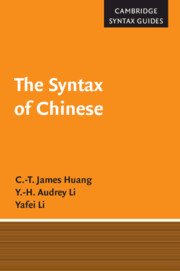2 - Argument structure
Published online by Cambridge University Press: 05 June 2012
Summary
Each category affects the grammaticality of a sentence differently. For verbs, the most conspicuous property is transitivity, which we investigate in this chapter. Following the convention in theoretical syntax, the subject and object(s) of a verb are called its arguments, and the semantic relation between a verb and any of its arguments called a thematic relation. The first section introduces the basic properties of thematic relations and demonstrates how they can help explain certain linguistic phenomena. A few recent attempts to understand the nature of thematic relations are critically reviewed in Section 2.2. An alternative theory is proposed in Section 2.3.
Arguments and theta-roles
It is obvious to any linguistically minded observer that in a typical active sentence built around a transitive action verb, such as ta chang minge ‘she sing folk.song’ or ni xie shi ‘you write poem,’ the subject argument is always the one initiating and performing the action while the object argument is always what is acted upon. This simple fact suggests the possibility that not every detail in the thematic relation between an argument and a verb matters in syntactic computation. For instance, ta ‘she’ and ni ‘you’ are subjects only because these NPs represent the “doers” of the actions; whether an action is done through singing or writing has no effect on qualifying an NP as the subject argument.
- Type
- Chapter
- Information
- The Syntax of Chinese , pp. 38 - 76Publisher: Cambridge University PressPrint publication year: 2009

